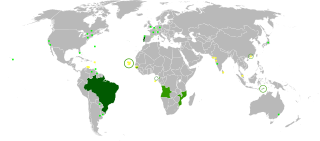| Poço das Antas Biological Reserve | |
|---|---|
| Reserva Biológica de Poço das Antas | |
IUCN category Ia (strict nature reserve) | |
 Aerial view of Poço das Antas Biological Reserve | |
Map of Brazil | |
| Location | Rio de Janeiro State, Brazil |
| Coordinates | 22°33′11″S42°16′55″W / 22.553°S 42.282°W Coordinates: 22°33′11″S42°16′55″W / 22.553°S 42.282°W |
| Area | 50 km2 (19 sq mi) |
| Designation | Biological Reserve |
| Established | 1974 |
Poço das Antas Biological Reserve (Portuguese : Reserva Biológica Poço das Antas) is a biological reserve located in Rio de Janeiro State, Brazil.

Portuguese is a Western Romance language originating in the Iberian Peninsula. It is the sole official language of Portugal, Brazil, Cape Verde, Guinea-Bissau, Mozambique, Angola, and São Tomé and Príncipe. It also has co-official language status in East Timor, Equatorial Guinea and Macau in China. As the result of expansion during colonial times, a cultural presence of Portuguese and Portuguese creole speakers are also found in Goa, Daman and Diu in India; in Batticaloa on the east coast of Sri Lanka; in the Indonesian island of Flores; in the Malacca state of Malaysia; and the ABC islands in the Caribbean where Papiamento is spoken, while Cape Verdean Creole is the most widely spoken Portuguese-based Creole. Reintegrationists maintain that Galician is not a separate language, but a dialect of Portuguese. A Portuguese-speaking person or nation is referred to as "Lusophone" (Lusófono).

A biological reserve in Brazil is a legally defined type of protected area of Brazil, a conservation unit that aims for full preservation of biota and other natural attributes without human interference. It may be visited only with prior approval of the responsible agency, and only for research or educational purposes.

Rio de Janeiro is one of the 27 federative units of Brazil. It has the second largest economy of Brazil, with the largest being that of the state of São Paulo.
Contents
The reserve, which covers 5,052 hectares (12,480 acres) in the Atlantic Forest biome, was created on 11 March 1974. It is administered by the Chico Mendes Institute for Biodiversity Conservation. [1]

The Atlantic Forest is a South American forest that extends along the Atlantic coast of Brazil from Rio Grande do Norte state in the north to Rio Grande do Sul state in the south, and inland as far as Paraguay and the Misiones Province of Argentina, where the region is known as Selva Misionera.

The Chico Mendes Institute for Biodiversity Conservation is the Brazilian Ministry of the Environment's administrative arm. It is named after the environmental activist Chico Mendes.
The reserve is in the municipality of Silva Jardim, Rio de Janeiro. The terrain is relatively flat, with elevations from 14 to 205 metres (46 to 673 ft). [2] Average annual rainfall is 2,400 millimetres (94 in). Temperatures range from 18 to 35 °C (64 to 95 °F) with an average of 23 °C (73 °F). The São João River defines the boundary of the reserve, which is laced with small springs, channels and streams. [2]

Silva Jardim is a municipality located in the Brazilian state of Rio de Janeiro. Its population was 21,349 (2010) and its area is 938 km².

The São João River is a river of Rio de Janeiro state in southeastern Brazil. It runs into the Atlantic at Rio das Ostras.











